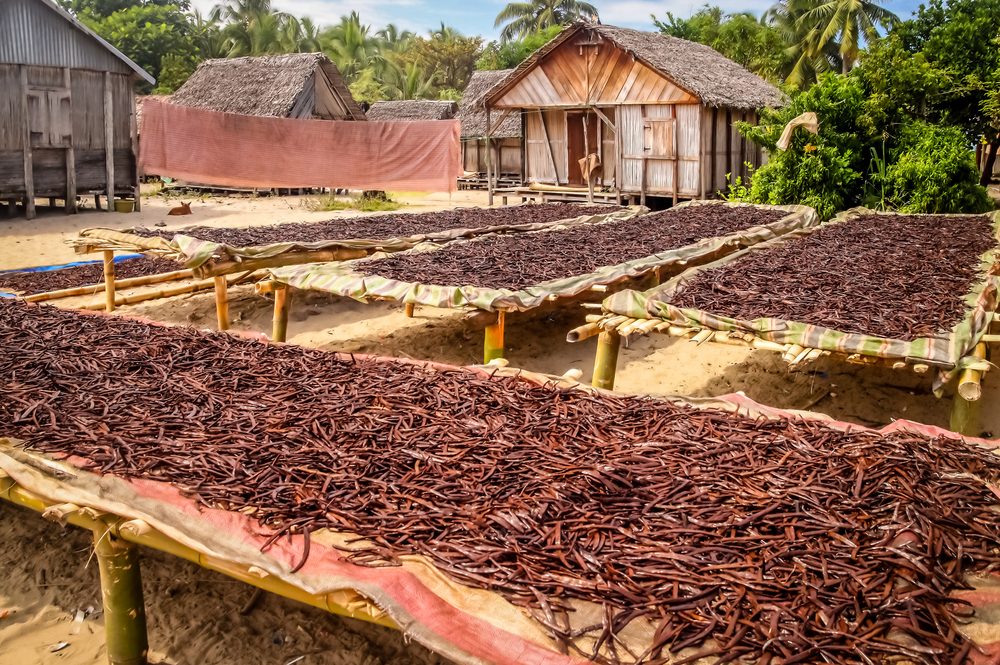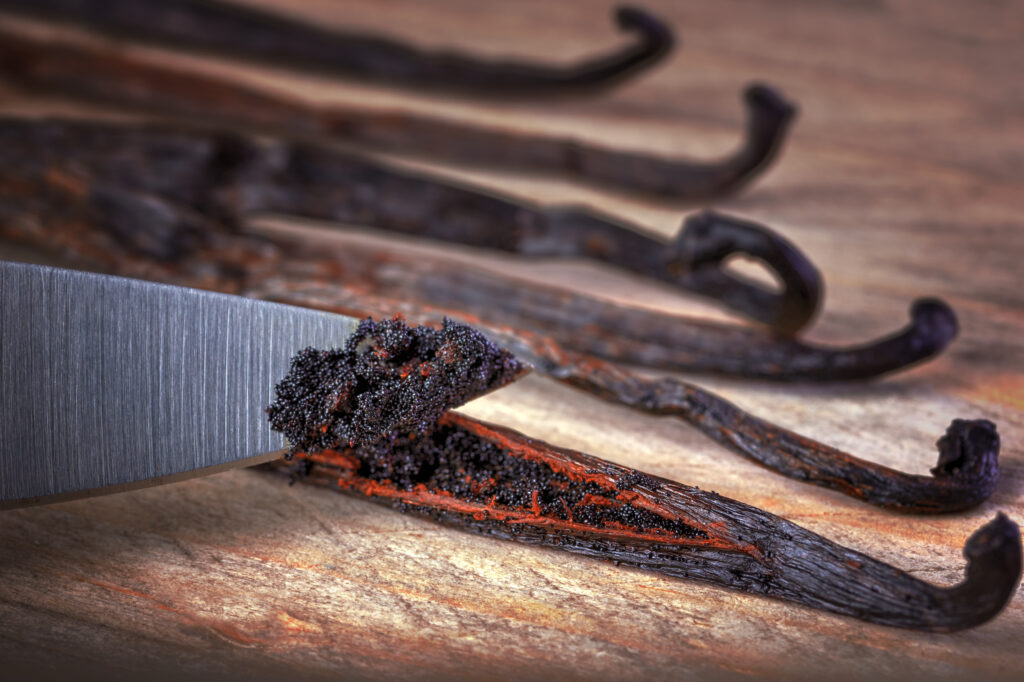Unraveling the Allure of Madagascar Vanilla
Madagascar Vanilla is a crowning jewel in the culinary world, widely renowned for its superior quality and flavor profile. This exotic spice, native to the lush rainforests of Madagascar, offers a uniquely rich and creamy taste with subtle hints of tobacco and wood. The fascinating allure of Madagascar Vanilla lies in its cultivation process, one that demands careful attention and artisanal craftsmanship. Farmers meticulously pollinate each vanilla orchid by hand, ensuring the development of the coveted beans. This labor of love and the island’s mineral-rich soils contribute to the vanilla beans’ robust aroma and exquisite flavor, making Madagascar Vanilla the most sought-after variety amongst chefs and gourmands alike.
The Unique Profile of Madagascar Vanilla Beans
The allure of Madagascar Vanilla beans comes from their complex flavor profile, resulting from a combination of terroir, variety, and processing methods. Grown from Orchidaceae Vanilla Planifolia, these beans develop a full-bodied taste with sweet, creamy overtones and a rich aroma. The beans are blanched, sweated, slow-dried, and cured over months, a traditional method that amplifies their fragrance and taste. The bean’s color, size, and moisture content are meticulously examined to determine its quality grade—factors that directly impact the depth of flavor it imparts to culinary and aromatic applications.
Madagascar’s Role in the Global Vanilla Industry
Madagascar’s tropical climate and fertile soil provide the perfect conditions for vanilla orchids to flourish, allowing it to produce nearly 80% of the world’s vanilla supply. This dominance in the global market means that any fluctuations in Madagascar’s vanilla cultivation, whether due to climatic events or economic pressures, can significantly impact global vanilla prices and availability. Madagascar’s vanilla industry is vital for global food and fragrance companies and a critical part of the local economy, providing livelihoods for thousands of farmers who depend on these flavorful pods for their income.

The Culinary Significance of Madagascar Vanilla
Classic Uses of Madagascar Vanilla in Baking and Desserts
Madagascar Vanilla has always been the go-to choice for pastry chefs and bakers worldwide. Its potent flavor ensures that even a small amount goes a long way in recipes. From classic French vanilla ice cream to crème brûlée and vanilla-infused custards, Madagascar Vanilla elevates the taste, imparting a comforting yet complex note. This spice is also a staple in cake and cookie recipes, harmonizing with other ingredients to create a phenomenal taste experience. Its versatility has made it an indispensable ingredient in kitchens both professional and home-based.
Exploring Savory Applications of Madagascar Vanilla
While vanilla is synonymous with sweets and desserts, its culinary application extends far into the savory spectrum. Chefs have increasingly been incorporating Madagascar Vanilla into sauces, glazes, and marinades to provide a subtle depth and sweet-smoky nuance. It pairs exceptionally well with shellfish like lobster and shrimp, balancing out the briny flavors. Vanilla can also be a unique addition to creamy soups or with earthy ingredients like mushrooms, offering a sophisticated twist to familiar dishes while teasing out a spectrum of flavors that reverberate on the palate.
The Art of Using Madagascar Vanilla in Cooking
Tips for Selecting and Storing Madagascar Vanilla
Selecting the finest Madagascar Vanilla begins with looking for plump, glossy beans that have a uniformly dark color and are flexible enough to wrap around a finger. Once acquired, it’s crucial to store vanilla beans in an airtight container away from direct light and heat to preserve their aromatic oils. Vanilla extract, made from these cherished beans, should also be kept in a cool, dark place to maintain its potency. Properly cared for, Madagascar Vanilla can retain its flavor for years, gradually maturing and deepening in complexity much like a fine wine.
Innovative Ways to Infuse Madagascar Vanilla into Dishes
Chefs and home cooks alike can be adventurous with Madagascar Vanilla, using it to add an unexpected twist to traditional recipes. Try scraping vanilla seeds into a balsamic reduction for a sweet-tart glaze perfect for meat dishes or incorporating it into a salt rub for a burst of aromatics on roasted vegetables. Infused spirits or syrups with vanilla can elevate cocktails and non-alcoholic beverages, and vanilla bean butter can bring a subtle richness to breakfast classics or seared steaks. The possibilities are truly vast when it comes to this aromatic spice.

Madagascar Vanilla Beyond the Kitchen
Madagascar Vanilla in Beverages and Confectioneries
Apart from its extensive use in cooking, Madagascar Vanilla is a beloved addition to beverages and confectioneries too. Its warm and welcoming taste makes it a popular choice in crafting high-end chocolate bars, truffles, and candies. In the realm of beverages, vanilla from Madagascar transforms coffee, tea, and even craft beers and spirits into aromatic luxuries. Baristas and mixologists often use Madagascar Vanilla syrup to add a touch of sweetness and flavor to lattes and cocktails, making it an essential element in both modern and classic drink recipes.
The Use of Madagascar Vanilla in Aromatics and Cosmetics
The enchanting scent of Madagascar Vanilla makes it a staple in the creation of perfumes, scented candles, and aromatherapy products. Its naturally relaxing and mood-uplifting qualities contribute to a calming atmosphere in homes and spas. In cosmetics, vanilla extract is added to lip balms, lotions, and body washes not only for its fragrance but also for its antioxidant properties that can help protect and repair the skin. The versatility of Madagascar Vanilla extends far and wide, proving its merit beyond the culinary sphere.
Savoring the Essence of Madagascar
Recipes Highlighting Madagascar Vanilla
Whether you’re a seasoned chef or simply an enthusiast in your home kitchen, incorporating Madagascar Vanilla into your recipes will add an unparalleled depth of flavor. Try a Madagascar Vanilla Bean Crème Anglaise to serve over fresh berries or as a delectable dip. Perhaps venture into making a Vanilla Bean Panna Cotta, a silky, soothing dessert that encases the essence of pure vanilla. For something savory, a Vanilla Bean Beurre Blanc makes an incredible sauce for delicate fish dishes, enhancing the flavor with a hint of something truly special.
Modern Culinary Creations with a Vanilla Twist
Madagascar Vanilla inspires contemporary culinary creations, demonstrating its adaptability to modern tastes and techniques. One such dish could be Vanilla and Cardamom-Scented Duck Breast, which combines exotic spices for a harmonious flavor profile. Another innovative dish is Lobster Tail with Vanilla-Infused Butter, a luxurious treat that pairs vanilla’s creaminess with seafood’s succulence. As culinary trends evolve, Madagascar Vanilla remains a constant source of inspiration for creative and experimental cooking, leaving diners with an unforgettable flavor experience.
Madagascar Vanilla: FAQs in Gourmet Cooking
Why use Madagascar Vanilla instead of other varieties?
Madagascar Vanilla, or Bourbon vanilla, is treasured for its full, creamy flavor and complex aroma. Unlike other varieties, it possesses a distinct profile cultivated from the island’s unique terroir and artisanal processing. Its richness and consistency in quality make it the top choice for chefs worldwide, enhancing everything from classic desserts to inventive savory dishes.
Can I reuse a Madagascar Vanilla bean?
Yes, you can. Even after the seeds are scraped out for a recipe, the remaining pod is still full of flavor. Wash and dry it, then submerge in a jar of sugar to create vanilla sugar, or add it to milk or cream when heating to infuse the liquid with vanilla essence. Reusing the bean is a cost-effective way to maximize its rich taste in your culinary creations.
Is there a difference between Madagascar Vanilla extract and vanilla paste?
Indeed, there is. Madagascar Vanilla paste contains the seeds from the pod and provides a more robust, more direct vanilla flavor with the speckled aesthetic that beans leave. On the other hand, extract is a solution of vanilla flavor in alcohol, giving a more subtle taste. Preference between paste and extract is often a matter of desired flavor intensity and visual presentation.
How do I substitute Madagascar Vanilla beans for extract?
When substituting beans for extract, a general guideline is that one Madagascar Vanilla bean equals about one tablespoon of vanilla extract. The size and potency of the bean can require slight adjustments to this ratio, so consider the strength of the bean and your taste preferences when making the swap.
What’s the best way to store Madagascar Vanilla beans?
The optimal storage method for Madagascar Vanilla beans is to seal them in an airtight container, ideally a glass tube or jar, and place them in a cool, dark area of your pantry. This method will help preserve their moisture and aromatic oils, maintaining the quality and flavor for as long as possible.
How can I tell if a Madagascar Vanilla bean has gone bad?
If a Madagascar Vanilla bean becomes very dry and brittle, lacks aroma, or displays mold, it has likely gone bad. Quality beans should be somewhat pliable and have a strong, sweet smell. Before use, examining the beans to ensure they’re still suitable for your recipes is always good practice.
Is Madagascar Vanilla sustainable?
Madagascar’s vanilla industry faces sustainability challenges due to high global demand and local issues. Ethical sourcing is key, and some farms and companies have taken steps towards sustainability through fair trade practices. Consumers can look for certifications that indicate sustainable and equitable farming practices to ensure their purchase supports the long-term health of this precious crop and its producers.
